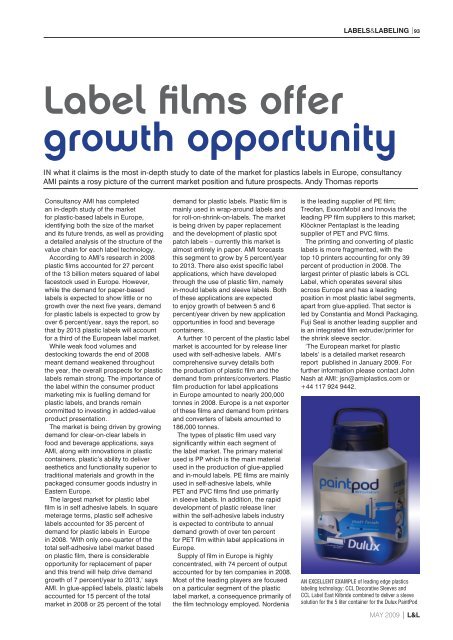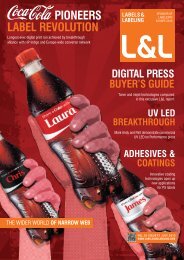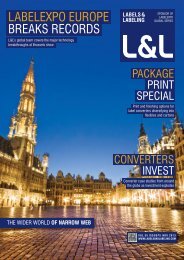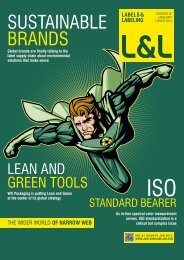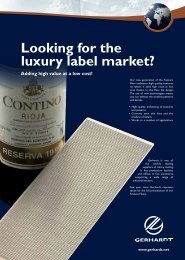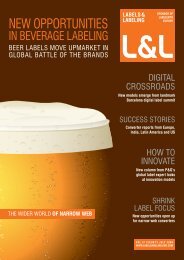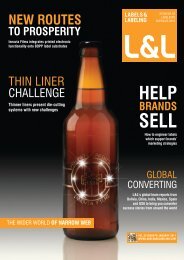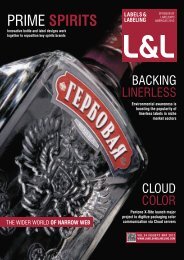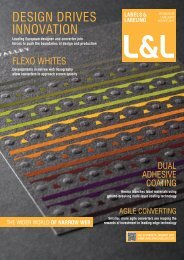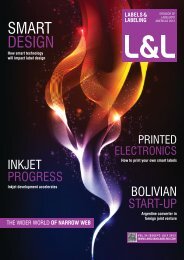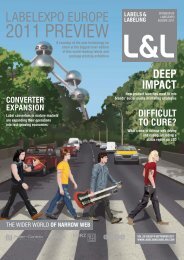THE DATA FRONT
Download as PDF - Labels & Labeling
Download as PDF - Labels & Labeling
- No tags were found...
You also want an ePaper? Increase the reach of your titles
YUMPU automatically turns print PDFs into web optimized ePapers that Google loves.
Labels&Labeling |93<br />
Label films offer<br />
growth opportunity<br />
In what it claims is the most in-depth study to date of the market for plastics labels in Europe, consultancy<br />
AMI paints a rosy picture of the current market position and future prospects. Andy Thomas reports<br />
Consultancy AMI has completed<br />
an in-depth study of the market<br />
for plastic-based labels in Europe,<br />
identifying both the size of the market<br />
and its future trends, as well as providing<br />
a detailed analysis of the structure of the<br />
value chain for each label technology.<br />
According to AMI’s research in 2008<br />
plastic films accounted for 27 percent<br />
of the 13 billion meters squared of label<br />
facestock used in Europe. However,<br />
while the demand for paper-based<br />
labels is expected to show little or no<br />
growth over the next five years, demand<br />
for plastic labels is expected to grow by<br />
over 6 percent/year, says the report, so<br />
that by 2013 plastic labels will account<br />
for a third of the European label market.<br />
While weak food volumes and<br />
destocking towards the end of 2008<br />
meant demand weakened throughout<br />
the year, the overall prospects for plastic<br />
labels remain strong. The importance of<br />
the label within the consumer product<br />
marketing mix is fuelling demand for<br />
plastic labels, and brands remain<br />
committed to investing in added-value<br />
product presentation.<br />
The market is being driven by growing<br />
demand for clear-on-clear labels in<br />
food and beverage applications, says<br />
AMI, along with innovations in plastic<br />
containers, plastic’s ability to deliver<br />
aesthetics and functionality superior to<br />
traditional materials and growth in the<br />
packaged consumer goods industry in<br />
Eastern Europe.<br />
The largest market for plastic label<br />
film is in self adhesive labels. In square<br />
meterage terms, plastic self adhesive<br />
labels accounted for 35 percent of<br />
demand for plastic labels in Europe<br />
in 2008. ‘With only one-quarter of the<br />
total self-adhesive label market based<br />
on plastic film, there is considerable<br />
opportunity for replacement of paper<br />
and this trend will help drive demand<br />
growth of 7 percent/year to 2013,’ says<br />
AMI. In glue-applied labels, plastic labels<br />
accounted for 15 percent of the total<br />
market in 2008 or 25 percent of the total<br />
demand for plastic labels. Plastic film is<br />
mainly used in wrap-around labels and<br />
for roll-on-shrink-on-labels. The market<br />
is being driven by paper replacement<br />
and the development of plastic spot<br />
patch labels – currently this market is<br />
almost entirely in paper. AMI forecasts<br />
this segment to grow by 5 percent/year<br />
to 2013. There also exist specific label<br />
applications, which have developed<br />
through the use of plastic film, namely<br />
in-mould labels and sleeve labels. Both<br />
of these applications are expected<br />
to enjoy growth of between 5 and 6<br />
percent/year driven by new application<br />
opportunities in food and beverage<br />
containers.<br />
A further 10 percent of the plastic label<br />
market is accounted for by release liner<br />
used with self-adhesive labels. AMI’s<br />
comprehensive survey details both<br />
the production of plastic film and the<br />
demand from printers/converters. Plastic<br />
film production for label applications<br />
in Europe amounted to nearly 200,000<br />
tonnes in 2008. Europe is a net exporter<br />
of these films and demand from printers<br />
and converters of labels amounted to<br />
186,000 tonnes.<br />
The types of plastic film used vary<br />
significantly within each segment of<br />
the label market. The primary material<br />
used is PP which is the main material<br />
used in the production of glue-applied<br />
and in-mould labels. PE films are mainly<br />
used in self-adhesive labels, while<br />
PET and PVC films find use primarily<br />
in sleeve labels. In addition, the rapid<br />
development of plastic release liner<br />
within the self-adhesive labels industry<br />
is expected to contribute to annual<br />
demand growth of over ten percent<br />
for PET film within label applications in<br />
Europe.<br />
Supply of film in Europe is highly<br />
concentrated, with 74 percent of output<br />
accounted for by ten companies in 2008.<br />
Most of the leading players are focused<br />
on a particular segment of the plastic<br />
label market, a consequence primarily of<br />
the film technology employed. Nordenia<br />
is the leading supplier of PE film;<br />
Treofan, ExxonMobil and Innovia the<br />
leading PP film suppliers to this market;<br />
Klöckner Pentaplast is the leading<br />
supplier of PET and PVC films.<br />
The printing and converting of plastic<br />
labels is more fragmented, with the<br />
top 10 printers accounting for only 39<br />
percent of production in 2008. The<br />
largest printer of plastic labels is CCL<br />
Label, which operates several sites<br />
across Europe and has a leading<br />
position in most plastic label segments,<br />
apart from glue-applied. That sector is<br />
led by Constantia and Mondi Packaging.<br />
Fuji Seal is another leading supplier and<br />
is an integrated film extruder/printer for<br />
the shrink sleeve sector.<br />
‘The European market for plastic<br />
labels’ is a detailed market research<br />
report published in January 2009. For<br />
further information please contact John<br />
Nash at AMI: jsn@amiplastics.com or<br />
+44 117 924 9442.<br />
An excellent example of leading edge plastics<br />
labeling technology: CCL Decorative Sleeves and<br />
CCL Label East Kilbride combined to deliver a sleeve<br />
solution for the 5 liter container for the Dulux PaintPod<br />
may 2009 | L&L


